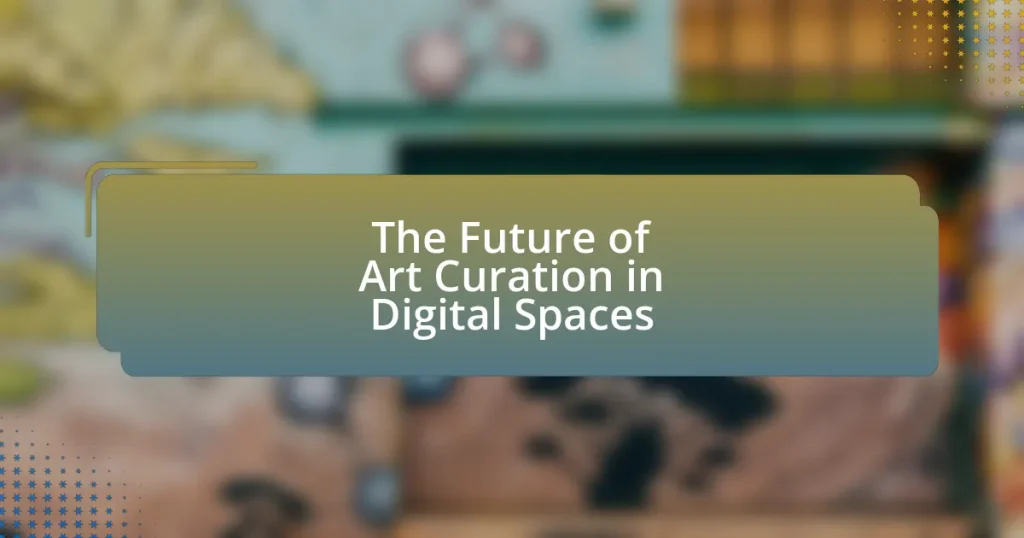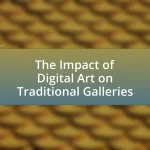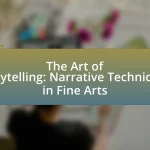The article focuses on the future of art curation in digital spaces, highlighting the integration of artificial intelligence, virtual reality, and augmented reality in enhancing audience engagement and accessibility. It discusses how digital technology is transforming traditional curation practices, enabling global reach and interactive experiences through platforms like Artland and Kunstmatrix. Key challenges such as accessibility, authenticity, and ethical considerations are examined, alongside the implications for artists and traditional art institutions. The article also outlines essential skills for curators in the digital landscape and best practices for ensuring inclusivity and evaluating the success of digital curation efforts.
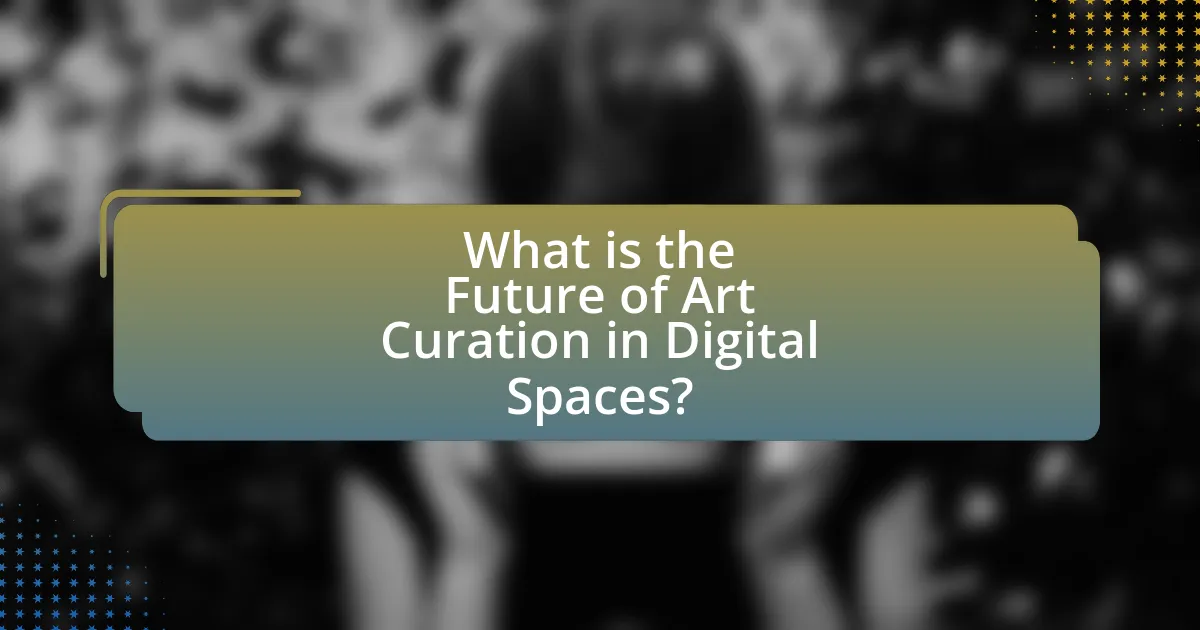
What is the Future of Art Curation in Digital Spaces?
The future of art curation in digital spaces will increasingly involve the integration of artificial intelligence and immersive technologies. As digital platforms evolve, curators will leverage AI algorithms to analyze audience preferences and curate personalized experiences, enhancing engagement. Additionally, virtual reality (VR) and augmented reality (AR) will allow for innovative exhibition formats, enabling viewers to interact with art in ways that transcend physical limitations. For instance, the rise of platforms like Artland and Kunstmatrix demonstrates how digital spaces can host dynamic exhibitions that reach global audiences, breaking geographical barriers. This shift is supported by the growing trend of online art sales, which accounted for 25% of the global art market in 2021, indicating a significant move towards digital engagement in the art world.
How is digital technology transforming art curation?
Digital technology is transforming art curation by enabling virtual exhibitions and enhancing audience engagement through interactive platforms. These advancements allow curators to reach global audiences without geographical limitations, as seen in initiatives like the Google Arts & Culture project, which has partnered with over 2,000 museums to provide online access to artworks and exhibitions. Additionally, technologies such as augmented reality (AR) and virtual reality (VR) create immersive experiences, allowing viewers to interact with art in innovative ways. For example, the VR platform Artland enables users to explore galleries and artworks in a 3D environment, significantly changing how art is experienced and curated.
What are the key technologies influencing digital art curation?
Key technologies influencing digital art curation include blockchain, artificial intelligence, virtual reality, and augmented reality. Blockchain technology ensures provenance and ownership verification of digital artworks, enhancing trust in transactions. Artificial intelligence aids in curating and recommending artworks based on user preferences and trends, streamlining the curation process. Virtual reality provides immersive experiences for viewers, allowing them to engage with art in a three-dimensional space, while augmented reality enhances physical art displays with digital overlays, creating interactive experiences. These technologies collectively transform how digital art is curated and experienced, making it more accessible and engaging.
How do these technologies enhance the viewer’s experience?
These technologies enhance the viewer’s experience by providing immersive and interactive environments that engage audiences more deeply with art. Virtual reality (VR) and augmented reality (AR) allow viewers to experience artworks in three-dimensional spaces, creating a sense of presence and emotional connection that traditional viewing cannot achieve. For instance, a study by the University of California, Irvine, found that VR experiences can increase emotional engagement with art by up to 30%, as users feel more involved in the narrative and context of the artwork. Additionally, digital platforms enable personalized experiences through algorithms that recommend artworks based on individual preferences, further enhancing viewer satisfaction and engagement.
What challenges does art curation face in digital spaces?
Art curation in digital spaces faces several challenges, including issues of accessibility, authenticity, and audience engagement. Accessibility is a significant concern, as not all users have equal access to technology or the internet, which can limit the reach of digital exhibitions. Authenticity poses another challenge, as the ease of reproducing and sharing digital art can lead to questions about the originality and ownership of works. Additionally, engaging audiences in a digital environment is difficult, as curators must compete with a vast array of online content, making it challenging to capture and maintain viewer interest. These challenges highlight the complexities of adapting traditional curation practices to the evolving digital landscape.
How do issues of accessibility impact digital art curation?
Issues of accessibility significantly impact digital art curation by determining who can engage with and experience digital artworks. Accessibility challenges, such as inadequate website design, lack of alternative text for images, and insufficient support for assistive technologies, can exclude individuals with disabilities from fully participating in the digital art space. For instance, a study by the National Endowment for the Arts found that only 20% of arts organizations in the U.S. have websites that meet basic accessibility standards, limiting access to their digital collections. This exclusion not only affects audience reach but also undermines the diversity and inclusivity that digital art curation aims to promote.
What are the ethical considerations in digital art curation?
Ethical considerations in digital art curation include issues of copyright, representation, and accessibility. Copyright concerns arise when curators use or display digital artworks without proper permissions, potentially infringing on artists’ rights. Representation is critical, as curators must ensure diverse voices and perspectives are included, avoiding biases that can marginalize certain groups. Accessibility involves making digital art available to a wider audience, including those with disabilities, which is essential for fostering inclusivity in the digital art space. These considerations are vital for maintaining integrity and fairness in the evolving landscape of digital art curation.
What trends are shaping the future of art curation in digital spaces?
The future of art curation in digital spaces is being shaped by trends such as increased use of artificial intelligence, immersive technologies like virtual and augmented reality, and the rise of decentralized platforms for art distribution. Artificial intelligence is streamlining the curation process by analyzing vast amounts of data to identify emerging artists and trends, as evidenced by platforms like Artfinder, which utilize algorithms to recommend artworks based on user preferences. Immersive technologies are transforming how audiences experience art, with virtual galleries allowing for interactive and engaging exhibitions, as seen in initiatives like the Museum of Other Realities. Additionally, decentralized platforms, such as blockchain-based art marketplaces, are empowering artists by providing direct access to collectors, thereby bypassing traditional gatekeepers in the art world. These trends collectively indicate a shift towards more accessible, personalized, and innovative approaches to art curation in digital environments.
How is the rise of virtual reality affecting art curation?
The rise of virtual reality is transforming art curation by enabling immersive experiences that enhance audience engagement and accessibility. Virtual reality allows curators to create interactive exhibitions where viewers can explore artworks in a three-dimensional space, breaking geographical barriers and reaching a global audience. For instance, the VR platform “The Night Cafe,” inspired by Vincent van Gogh, allows users to walk through a digital recreation of the artist’s world, demonstrating how technology can deepen the connection between art and viewer. This shift not only redefines the physical limitations of traditional galleries but also encourages innovative storytelling methods, making art more relatable and engaging for diverse audiences.
What role do social media platforms play in digital art curation?
Social media platforms serve as vital tools for digital art curation by enabling artists to showcase their work to a global audience and facilitating community engagement. These platforms, such as Instagram and Pinterest, allow artists to share their creations instantly, reaching potential collectors and art enthusiasts without the barriers of traditional galleries. According to a 2021 survey by Art Basel and UBS, 63% of collectors reported discovering new artists through social media, highlighting its significant impact on art visibility and accessibility. Furthermore, social media fosters interaction between artists and audiences, creating a dynamic environment for feedback and collaboration, which enhances the curation process.
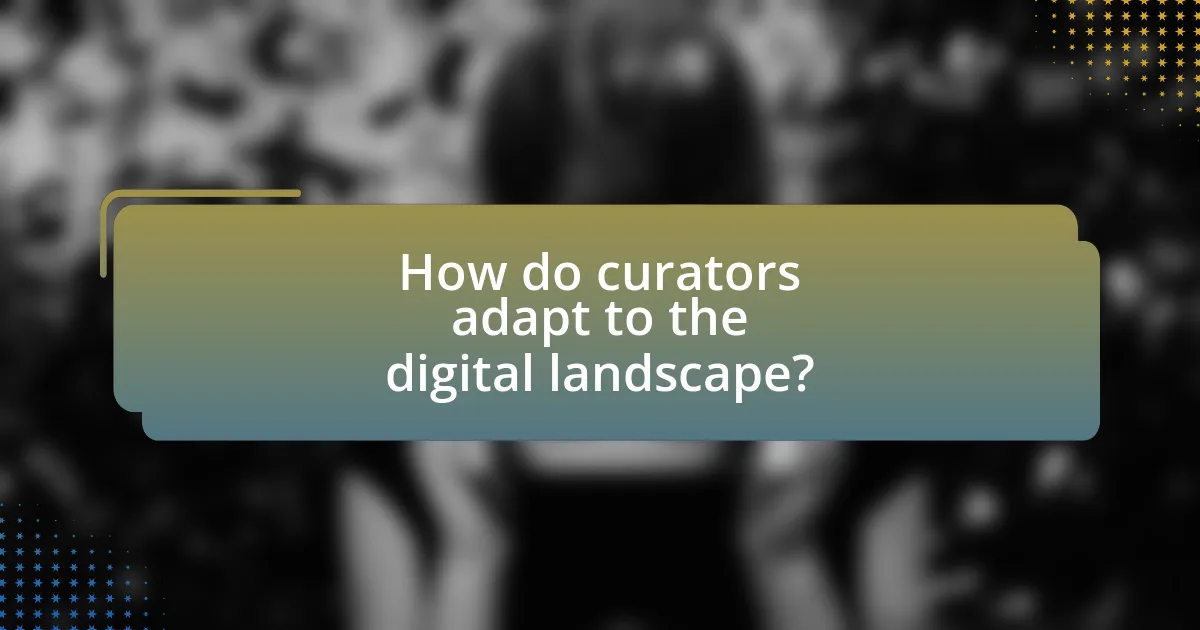
How do curators adapt to the digital landscape?
Curators adapt to the digital landscape by integrating technology into their practices, enhancing accessibility and engagement with audiences. They utilize digital tools such as virtual reality, augmented reality, and online platforms to create immersive experiences and broaden the reach of exhibitions. For instance, institutions like the Museum of Modern Art have launched online collections and virtual tours, allowing global audiences to experience art remotely. This shift not only democratizes access to art but also fosters innovative ways of storytelling and interaction, as seen in projects like the Google Arts & Culture initiative, which collaborates with museums worldwide to digitize and share their collections.
What skills are essential for curators in digital environments?
Essential skills for curators in digital environments include digital literacy, content management, and data analysis. Digital literacy enables curators to navigate various digital platforms and tools effectively, ensuring they can curate and present art in engaging ways. Content management skills are crucial for organizing and maintaining digital collections, allowing curators to create cohesive narratives and experiences. Data analysis skills help curators understand audience engagement and preferences, facilitating informed decisions about exhibitions and programming. These skills are increasingly vital as the art world shifts towards digital platforms, where effective curation relies on a blend of technology and artistic insight.
How can curators leverage data analytics in their work?
Curators can leverage data analytics by utilizing insights from audience engagement metrics to enhance exhibition design and content curation. By analyzing visitor data, such as foot traffic patterns and online interactions, curators can identify popular artworks and themes, allowing them to tailor exhibitions that resonate with their audience. For instance, a study by the American Alliance of Museums found that institutions using data analytics reported a 30% increase in visitor satisfaction and engagement. This demonstrates that data-driven decisions can lead to more effective curation strategies, ultimately enriching the visitor experience in digital and physical spaces.
What training opportunities exist for curators focusing on digital art?
Training opportunities for curators focusing on digital art include specialized workshops, online courses, and degree programs that emphasize digital media and contemporary art practices. Institutions such as the School of Visual Arts offer a Master of Fine Arts in Art Practice with a focus on digital art, while platforms like Coursera and edX provide courses on digital curation and art management. Additionally, organizations like the Museum of Modern Art (MoMA) and the Tate Modern frequently host seminars and training sessions aimed at enhancing curatorial skills in the digital realm. These programs equip curators with the necessary skills to navigate the complexities of digital art, including understanding technology, audience engagement, and the preservation of digital works.
How do curators engage audiences in digital spaces?
Curators engage audiences in digital spaces by utilizing interactive technologies and social media platforms to create immersive experiences. They employ tools such as virtual reality, augmented reality, and live streaming to enhance viewer participation and accessibility. For instance, the use of virtual exhibitions allows audiences to explore artworks from anywhere in the world, breaking geographical barriers. Additionally, curators often leverage social media to foster community engagement, encouraging discussions and feedback through comments and shares. This approach not only democratizes access to art but also cultivates a sense of belonging among diverse audiences, as evidenced by the increased online participation in art events during the COVID-19 pandemic, where virtual attendance surged by over 300%.
What strategies can curators use to foster community online?
Curators can foster community online by creating interactive platforms that encourage engagement and collaboration among users. These platforms can include social media groups, forums, and virtual exhibitions where participants can share their thoughts and experiences. For instance, curators can host live Q&A sessions or webinars that allow community members to interact directly with artists and experts, enhancing the sense of belonging. Additionally, curators can implement user-generated content initiatives, inviting community members to contribute their own artworks or stories, which can strengthen connections and promote inclusivity. Research indicates that active participation in online communities leads to higher satisfaction and loyalty among members, demonstrating the effectiveness of these strategies in building a vibrant online community.
How can interactive elements enhance audience engagement?
Interactive elements enhance audience engagement by actively involving participants in the experience, leading to increased attention and retention. Research indicates that interactive features, such as polls, quizzes, and virtual reality experiences, can significantly boost user interaction; for instance, a study by the Nielsen Norman Group found that users are 50% more likely to engage with content that includes interactive components. This heightened engagement occurs because interactive elements create a sense of participation and investment, making the audience feel more connected to the content and the curator.
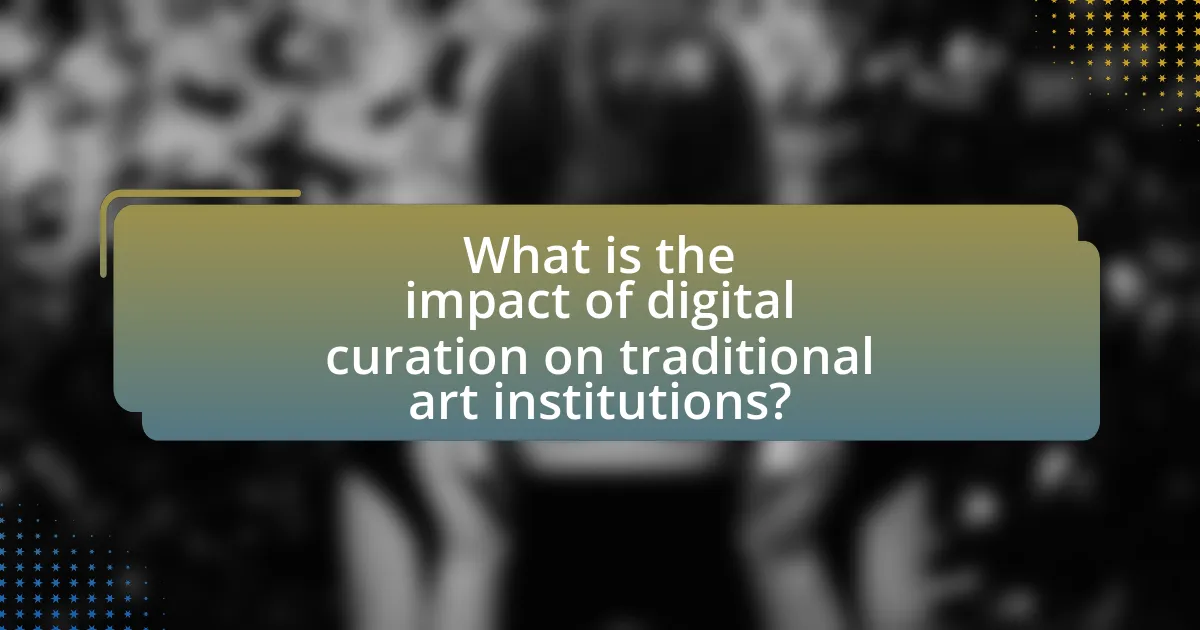
What is the impact of digital curation on traditional art institutions?
Digital curation significantly enhances traditional art institutions by expanding their reach and accessibility. Through online platforms, these institutions can showcase collections to a global audience, breaking geographical barriers that previously limited access to art. For instance, the Louvre Museum reported a 30% increase in online visitors after launching its digital curation initiatives, demonstrating the effectiveness of this approach. Additionally, digital curation allows for interactive experiences, such as virtual tours and augmented reality, which engage audiences in innovative ways. This shift not only attracts younger demographics but also fosters a deeper connection between the public and art, ultimately revitalizing traditional institutions in the digital age.
How are museums adapting to the digital curation trend?
Museums are adapting to the digital curation trend by implementing virtual exhibitions, enhancing online accessibility, and utilizing social media for engagement. For instance, institutions like the Louvre and the British Museum have developed virtual tours that allow global audiences to explore their collections remotely, significantly increasing visitor reach. Additionally, museums are investing in digital archives and interactive platforms, which facilitate user engagement and education. According to a report by the American Alliance of Museums, 85% of museums have increased their digital presence in response to the COVID-19 pandemic, highlighting a significant shift towards embracing technology in curation practices.
What changes are being made to exhibition formats in response to digital curation?
Exhibition formats are increasingly incorporating interactive and immersive elements in response to digital curation. This shift includes the use of virtual reality (VR) and augmented reality (AR) technologies, allowing audiences to engage with artworks in innovative ways. For instance, institutions like the Museum of Modern Art have implemented VR experiences that enable viewers to explore art in a three-dimensional space, enhancing accessibility and engagement. Additionally, digital platforms are facilitating hybrid exhibitions that combine physical and online elements, broadening audience reach and participation. This evolution reflects a growing trend towards integrating technology to create more dynamic and inclusive art experiences.
How do digital initiatives influence museum funding and sponsorship?
Digital initiatives significantly enhance museum funding and sponsorship by attracting a broader audience and increasing engagement through online platforms. These initiatives, such as virtual exhibitions and interactive digital content, allow museums to reach global audiences, which can lead to increased ticket sales, merchandise purchases, and donations. For instance, the American Museum of Natural History reported a 300% increase in online donations during its virtual events, demonstrating the financial impact of digital engagement. Furthermore, corporate sponsors are more likely to invest in museums that showcase innovative digital projects, as these initiatives align with their branding strategies and commitment to technology. This trend is supported by a 2021 report from the International Council of Museums, which found that 70% of museums that implemented digital strategies saw an increase in sponsorship opportunities.
What are the implications of digital curation for artists?
Digital curation significantly impacts artists by enhancing their visibility and accessibility to global audiences. Through platforms like social media and online galleries, artists can showcase their work to a wider demographic, breaking geographical barriers. This increased exposure can lead to greater opportunities for collaboration, sales, and recognition in the art community. Furthermore, digital curation allows artists to engage directly with their audience, fostering a more interactive relationship that can influence their creative process. The rise of digital art forms and NFTs also provides new revenue streams, enabling artists to monetize their work in innovative ways.
How does digital curation affect an artist’s visibility and reach?
Digital curation significantly enhances an artist’s visibility and reach by strategically organizing and promoting their work across various online platforms. This process allows artists to connect with broader audiences, as curated content is often shared through social media, art websites, and digital galleries, increasing exposure. For instance, a study by the National Endowment for the Arts found that artists who engage in digital curation see a 30% increase in online engagement compared to those who do not. This increased visibility can lead to more opportunities for collaboration, sales, and recognition in the art community.
What opportunities does digital curation create for emerging artists?
Digital curation creates significant opportunities for emerging artists by providing them with platforms to showcase their work to a global audience. These platforms, such as social media, online galleries, and digital exhibitions, allow artists to reach potential buyers and collaborators without the constraints of traditional gallery spaces. For instance, platforms like Instagram and Behance have enabled artists to gain visibility and build a following, leading to increased sales and commissions. Additionally, digital curation facilitates networking opportunities through virtual events and online communities, which can lead to collaborations and mentorships that are crucial for career development.
What best practices should curators follow in digital spaces?
Curators in digital spaces should prioritize accessibility, engagement, and ethical practices. Accessibility ensures that diverse audiences can interact with digital content, which can be achieved by using clear navigation, alt text for images, and responsive design. Engagement involves creating interactive experiences that invite user participation, such as virtual tours or social media integration, which can enhance viewer connection and investment in the artwork. Ethical practices include respecting copyright laws and ensuring that the representation of artists and their work is fair and accurate, fostering a trustworthy environment. These best practices are supported by research indicating that accessible and engaging digital experiences lead to higher audience satisfaction and retention rates.
How can curators ensure inclusivity in digital exhibitions?
Curators can ensure inclusivity in digital exhibitions by actively engaging diverse communities in the planning and execution processes. This approach includes soliciting input from underrepresented groups, incorporating a wide range of perspectives, and ensuring accessibility features are integrated into the digital platform. Research indicates that inclusive practices not only enhance audience engagement but also reflect a broader spectrum of cultural narratives, as seen in initiatives like the Smithsonian’s “Our Shared Future” project, which emphasizes collaboration with various cultural stakeholders.
What are effective methods for evaluating the success of digital curation?
Effective methods for evaluating the success of digital curation include analyzing user engagement metrics, assessing content relevance, and measuring the impact on audience knowledge and behavior. User engagement metrics, such as page views, time spent on content, and interaction rates, provide quantitative data on how audiences are interacting with curated materials. Assessing content relevance involves gathering user feedback and conducting surveys to determine if the curated content meets audience needs and interests. Additionally, measuring the impact on audience knowledge and behavior can be achieved through pre- and post-engagement assessments, which can reveal changes in understanding or attitudes towards the subject matter. These methods collectively provide a comprehensive evaluation framework for digital curation success.










